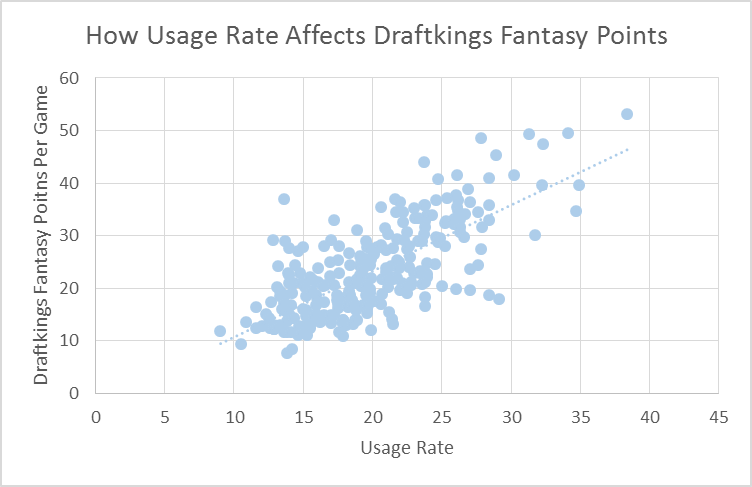Why Skill Sets Matter With Usage Rate
Not all players’ fantasy point outputs rely solely on scoring. Some players, such as DeAndre Jordan, do most of their damage in the rebounding and defensive categories. Conceptually it makes sense that more shots lead to more points, but does it directly lead to more fantasy points?

Here’s the thing with just assuming shooting more leads to a greater fantasy point output: players shoot at vastly different percentages. Kemba Walker averaged 16.7 shots per-36 minutes but only shot the ball at a 38.5% clip. By comparison, Carlos Boozer took 15.8 shots per-36 minutes and made 49.9% of them. In theory if they played the same allotment of minutes with the identical usage rate, Boozer would score more points. This puts a bit of a wrinkle on the blanket statement “more shots equals more points.”
To account for players of all skill sets, looking at the overall fantasy picture instead of just points (which we know plays its role in overall fantasy output) seemed like more transferable knowledge to the DFS game. And 1,000 minutes yet again was the plateau for the data to eliminate the small sample size. Assuming the data would be more sporadic with varying degrees of skill sets, here is how usage rate correlated with DraftKings fantasy points per game.

The correlation’s strength decreased comparatively to points alone. This suggests that examining a player’s skill set as a whole is important for the daily game because scoring is not the only way to accumulate fantasy points. Players that run the offense are more directly affected by usage rate than others. For instance, if Rajon Rondo were to sit out for the Kings this upcoming season, Darren Collison (career 20.4% usage) would run a healthy amount of the offense. When Jason Thompson sat out last season and Reggie Evans (career 12.1% usage) was forced to fill in, he was virtually non-existent in the offense in concurrent with his career skill set. He’s one of the league’s best rebounders and that’s just what he does when you examine the numbers year after year. Despite playing an extended role and producing a greater fantasy point total due to the extended minutes, the usage rate would remain low.
The unaccounted for variable in this lesson is the fact that roles change on a game-by-game basis. Last season when Kevin Durant went down, Russell Westbrook took even a larger chunk of the offense into his hands. When Kyle Lowry was injured last season, DeMar DeRozan handled the ball more often which led to him scoring 24.3 points per game and 4.1 assists per game compared to just 19.1 points per game and 3.5 assists per game with Lowry on the court. Getting your hands on how an offense transforms with varying personnel packages on the floor is a vital part of the daily fantasy game and leads me to my final lesson.
In The Most Important Statistic in NBA DFS: Usage Rate, you’ll learn:
• What exactly is usage rate and why is it so important in NBA DFS?
• How to apply this NBA real-life stat to daily fantasy basketball
• How a player’s skill set is an important factor in their usage rate
• How a player’s role is an important factor in their usage rate
Want to keep reading? Purchase the course and learn from the best!
